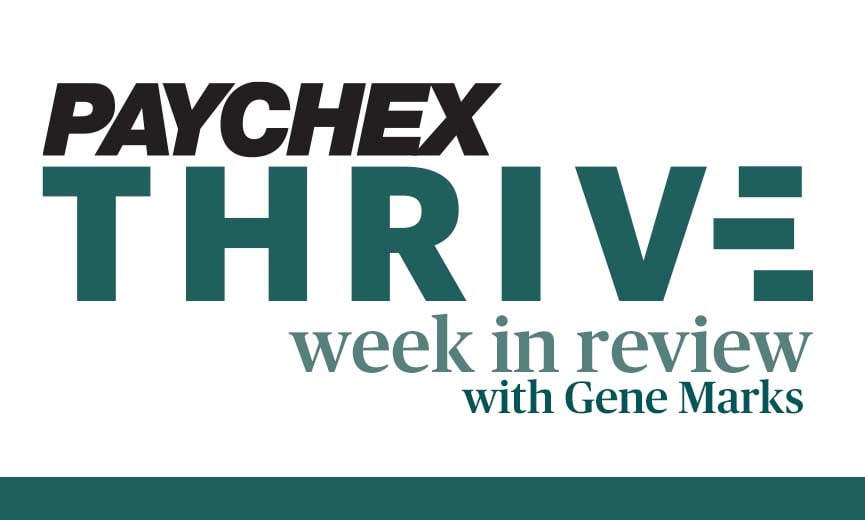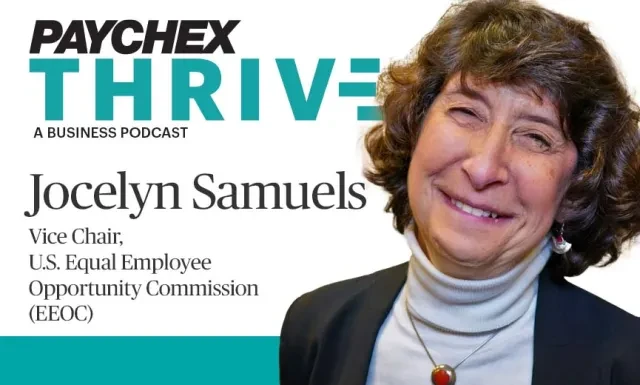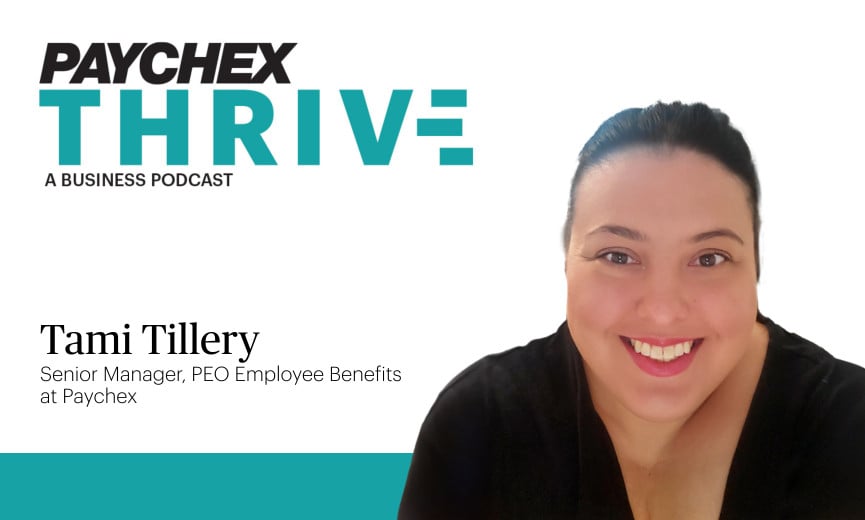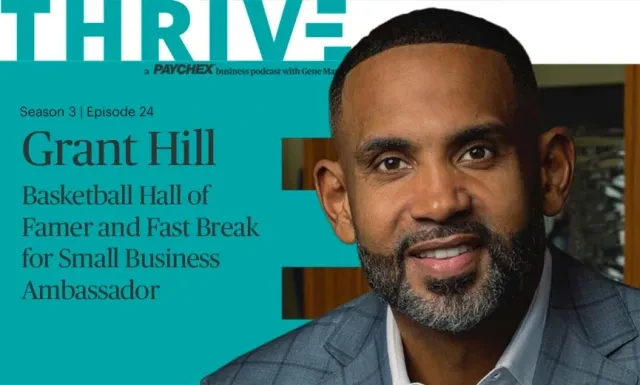Preparando el éxito: Cómo Starbucks impulsa el crecimiento de las pequeñas empresas
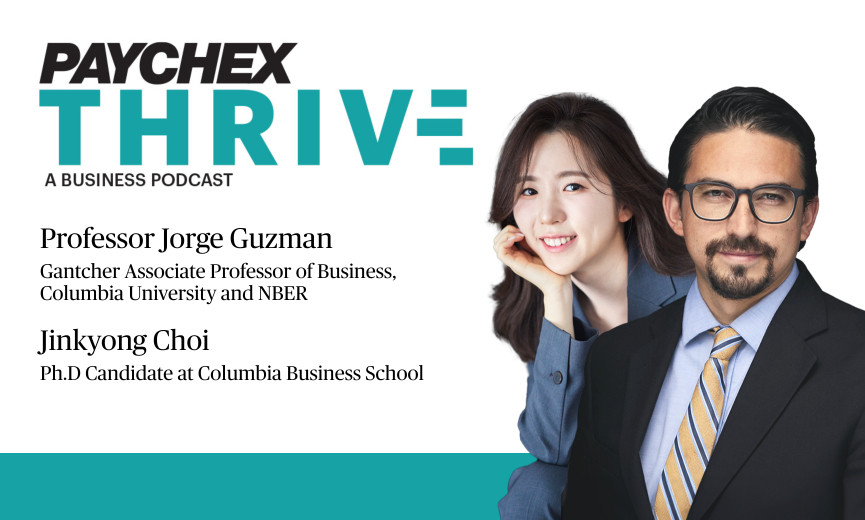
Podcast •

Vea
Resumen
A new study from two of Columbia Business School's brightest minds, Jinkyong Choi and Jorge Guzman, reveals a striking correlation between the opening of Starbucks locations and a subsequent increase in local business activity. They join this episode of Paychex THRIVE to discuss this phenomenon and share why Starbucks, with its inviting atmosphere for lingering and networking, is accelerating small business growth.
Topics include:
00:00 – Episode preview and welcome
00:53 – Welcome and introduction of guests
02:28 – Jorge Guzman’s background
03:15 – Jin Choi’s background
03:54 – Overview of Choi and Guzman’s study
05:53 – Impact of Starbucks on local entrepreneurship
07:16 – Comparison with other coffee shops
09:52 – Starbucks' role in supporting freelancers
11:17 – Methodology of the study
13:16 – Is Starbucks choosing growing areas vs. causing growth?
14:28 – Implications of zoning board decisions on Starbucks locations
17:01 – Data sources for the study
18:02 – Impact of COVID-19 and study considerations
19:02 – Takeaways and strategies for small business owners
20:47 – Benefits of opening a business near a Starbucks
23:17 – Discussion on research about Starbucks and neighborhood entrepreneurship
24:28 – Wrap up and thank you
Ver transcripción
Jinkyong Choi (00:00)
Yeah. So, I think the implication of our study for business owners, especially the small business owners who are the main listeners of your podcast, is that actually, like, fostering local communities could be a business strategy really viable for small business owners. Because if you position yourself as a place where you can foster your community, you attract a lot of entrepreneurs into your place so you can start really small, like what Starbucks did. Like, just create, just by creating a local atmosphere that brings a lot of people into your place and let them linger around your place and connect with other people, that could bring a lot of benefit not only to the community, but also for your business.
Announcer (00:53)
Welcome to Paychex THRIVE, a business podcast where you'll hear timely insights sites to help you navigate marketplace dynamics and propel your business forward. Here's your host, Jose Guzman.
Gene Marks (01:09)
Hey, everybody, and thanks again for joining us for another episode of the Paychecks THRIVE podcast. My name is Gene Marks, and I'm really happy that you are here. I have two guests today, two academic guests. I have Jorge Guzman. Jorge is the Gantcher Associate Professor of Business at Columbia University and a faculty research fellow at the National Bureau of Economic Research for Productivity, Innovation, and their Entrepreneurship program. Jorge, I'm going to ask you who Gantcher is in just a moment. I'm just kidding. Maybe you do know, but I will get to you in just a moment. He is joined by Jin Choi. Jin is a third-year Ph.D. student in management at the Columbia Business School. So, both of you guys, thank you so much for joining me.
Jorge Guzman (01:55)
Thank you. We're happy to be here. Nate Gantcher is an excellent person. I did have the chance to have lunch with him.
Gene Marks (02:01)
All right, tell me, who is Gantcher again?
Jorge Guzman (02:03)
Well, Nate Gantcher is benefactor to school, and he's very successful in finance and part here of the Columbia family. He was on the board a long time.
Gene Marks (02:15)
Got it, got it. And I guarantee I've never heard of him. I'm sure he's a good guy, and I'm sure that you're benefiting from his funding. So, we want to make sure we say all the right. Fair enough. Just briefly, give us a little bit about your background. And, Jin, I'm going to come to you in a minute and ask you the same question. Go ahead.
Jorge Guzman (02:35)
Yeah. So, I've been here at Columbia for six years now. This is my 7th year where I teach entrepreneurship. I brought a class, introduced a class called entrepreneurial strategy, which tries to think, how do entrepreneurs develop a distinct advantage that is successful in the market? I also do a lot of research on entrepreneurship policy and things like that. Before coming here, I did an MBA and a Ph.D. at MIT in the Sloan School of Management. And before that, I was a software developer, and I did a computer engineering degree in Tech de Monterrey in Mexico. That's the story.
Gene Marks (03:15)
That's great. All right. That is really good. And, Jin, how about you? Are you a student? You're a PhD student?
Jinkyong Choi (03:20)
Yeah. So, I'm a third-year PhD student at the management division here at Columbia Business School, and I'm interested in innovation, entrepreneurship. And before joining here, I did master's in public policy at the University of Chicago, and I worked at the Stickler Center of Economic and Government there. And also, before that, I was working in Korean Communications Commissions as a deputy director, where I oversaw the ethics and the competitive policy of artificial intelligence.
Gene Marks (03:53)
That is awesome. Okay, so now the two of you guys and one other of your colleagues worked on this study, which was recently published at the National Bureau of Economic Research. And the study is called Third Places in Neighborhood Entrepreneurship: Evidence from Starbucks Cafe.
Jorge Guzman (04:08)
That's right.
Gene Marks (04:08)
So, let's talk a little bit about the background from this study. First of all, whose idea was it to do such a study, and what were you guys hoping to accomplish at the very beginning? I don't know. Which one of you guys want to answer that question?
Jorge Guzman (04:22)
Well, I'll get started, and then I'll let Jin jump in. So, it's actually, you know, the paper is about proximity, and it's interesting because it starts Mario Small, our collaborator, who was in sabbatical and decided to come to the business school. And he had the office right next to mine. And Jin had just started her PhD, and she had the desk kind of ten steps from here. And sort of the thing we wanted to study was sort of, we wanted to think about three things at the same time. First, we want to study more entrepreneurship and the antecedents of what makes it successful, but we wanted to make it very local. Right. Because we really want to think about where you are, not as New York versus Philly like you and me, Jin, but sort of the people around you. And how do you connect to those? We know that it's so different. Just based on the floor that you are, you might find very different level of connections. And we really connected to this idea of third places, which is an old idea in sociology that having sort of think about as the Cheers bar, right. Having a place where everybody knows your name, where you belong. Add something. Now, all the previous work, it kind of focused on social action. You might think the role of bars in creating kind of revolution and things like that with a little bit on innovation, but nothing, you know, it was interesting because entrepreneurship is important for neighborhoods, but nothing had been done to even think about how the space in a neighborhood kind of shapes that.
Gene Marks (05:53)
Right? So, the idea here is to. And, Jin, this is for you. So the idea here is to take something like a Starbucks and be like, you know, when a Starbucks opens in a neighborhood, what impact does that have on other business and entrepreneurship? Am I describing that correctly?
Jinkyong Choi (06:09)
Yeah, exactly. So, yeah, we looked at the first entry of Starbucks into a neighborhood as the neighborhood's first ever coffee shop and how that affects the local entrepreneurship. So, like, the formation of new businesses in the neighborhood. And we found, I mean, as you already know, we found that there is around like 5% increase in the new businesses in the neighborhood where Starbucks first enter as a new coffee shop compared to other places where it did not enter.
Gene Marks (06:42)
Is it... Is this just a Starbucks phenomena, or do you think that, you know, this could be any coffee shop or any, you know, any brand? And, Jin, that's for you.
Jinkyong Choi (06:51)
Yeah. So, actually, we had an additional analysis within the paper which looks at other coffee shops, such as Dunkin Donuts or the Kerry Blue coffee, if you know about it. And we found that, like, the places where its main businesses were takeout coffees, such as in Dunkin Donuts case, they didn't have as much impact as Starbucks did. And for coffee shop that were similar to Starbucks in terms of it attracted a lot of people to connect within the place, it had a very positive impact, similar to Starbucks. So I think that kind of describes how the places that act as places that attract a lot of people to connect with affects entrepreneurship in the neighborhood.
Gene Marks (07:39)
So, it's not really just serving coffee or having a takeout coffee place, but it's the combination of that and having a place where people can go and meet and network and hang out. It's funny, I live in Center City, Philadelphia now, but we raised our kids in a suburb of Philadelphia. And guys, I remember this. This was like 15 years ago, a Starbucks opened up in a small strip mall near my house. And it was like, it was in a strip mall on a road. Like, I was like, what are they thinking? Like, you know, who's going to go there? And why would they pick that one location? And as it turns out, not only is that Starbucks still there, but it absolutely validates what your research has shown. It's thriving, and there have been other businesses that have opened up around it. I've noticed over the past 15 years. And I think that the fact that Starbucks is there is a big part of this. Jorge, I know you can analyze brick and mortar businesses, but you also, in your study, analyze, and could you analyze other types of businesses? Starbucks attracts freelancers and independent contractors and those types of, and they're business owners, but it's a little harder to track, were you able to do that?
Jorge Guzman (08:52)
Right. And I think what you're saying is, look, there's different ways Starbucks helps. Of course, there's something about a retail brand of Starbucks, right? I mean, that's going to open other restaurants or other kind of fashion separately. There's something about Starbucks as a place to connect. And as you said, freelancers would take meetings there. You know, people have a time to find each other. We do some of that. So we do show the effect holds for retail and food specifically. But it's not only that, and there's a lot more than that. We wish. That is one of the opportunities we hope to get into in the future. We wish we could actually look at the different job opportunities, especially for home-based businesses, which are booming so much after COVID and where we think. It's actually kind of contradictory, right. Because the homemade businesses, they might be helped even more by an actual physical space to go to and work for some time rather than just being at home, for example.
Gene Marks (09:52)
Yeah, that was exactly, that's exactly my point. I mean, it just, it provides that extra office space for those home-based businesses, and it makes sense if they are closely around. Jin, did you guys talk to anybody at Starbucks? I mean, did you, was there any part of your, and again, if not, that's fine, but I mean, was that any part of the methodology of this to find out how they chose locations and why they opened up in certain places? Or was this just an after the fact analogy of, or analysis of what businesses are sprout up because there's a Starbucks there?
Jinkyong Choi (10:26)
Yeah, I mean, we didn't directly interact with Starbucks employees or Starbucks location professionals, but we did go through a lot of Reddits where people talked about those places. And also we talked with a lot of local coffee shop owners. One of them is Dear Mama, which is right next to Columbia Business School. And I talked to the owner and he talked about, like, his location strategy and stuff like that. And also, we listened to Howard Schultz himself explaining his strategy in other podcasts or like, books. And it was pretty clear that he had a clear vision in his mind in terms of his location strategy. So, I think that really helped us get to know what the location strategy of Starbucks is.
Jorge Guzman (11:17)
And I'll add one thing, which is a little bit in the weeds, but I think it's a compliment to Jin's skills, which is she also went through all the old news results in a platform we have here at Columbia called LexisNexis. And she found the news for Starbucks that were supposed to open, but then they couldn't open for some reason, you know, permitting or whatever. And that was very good for us because we sort of could run our study also within places that Starbucks tried to open, but some did and some didn't. And so that allowed us kind of more confidence in the comparison. That was a very...
Gene Marks (11:53)
Yeah, that makes sense. How much of this do you think is, like chicken or the egg kind of thing? You know, like Starbucks chooses an area because they, based on their location scouting, they know that this is a place that's going to be like a growing area, both for businesses and, you know, in residence or the other way around. You know, it grows because Starbucks is there. How do you, how can you account for that when you do. Yeah.
Jorge Guzman (12:16)
Yeah. So there's, there's three points on that, right? One of them is we actually only found Starbucks helps when there's no previous coffee shops and local, or in sort of a lot of space in the area. If it's an area that already has a lot of local kind of coffee shops and other places to be, adding a Starbucks doesn't make a big difference. So that that's, so that kind of gives us confidence. It's something about adding to actually the fabric of the neighborhood in a new away. When we, so we do, so the first thing is, for a booming area, the typical thing one might look at is real estate prices. And we show that while there might be changes over time, the Starbucks itself is not driving those changes. And then the second thing that we could look at is we sort of look at, you know, this is, again, kind of statistical things that we do, but we look at that, what we're called pre-trends, sort of how it's kind of changing in the years before. And can we sort of account for that? And we find that in these cases where Starbucks adds the very first coffee shop, sort of, there are no pre trends. Finally, the last thing we do is we look at one case where Starbucks hadn't planned to open in a bunch of cities, but then eventually decided to when they went in and collaborated with Magic Johnson. And so what's nice about that is that sort of, they chose them very quickly. It wasn't a plan for a long time, and that makes a difference.
Jinkyong Choi (13:40)
I also want to add that our main analysis just focuses on the Starbucks, focus on the neighborhoods that Starbucks seriously consider to open their new location. So we had neighborhoods that Starbucks managed to open, and we had neighborhoods that Starbucks really wanted to open but couldn't open because of external hurdles that are not related to economic potential of the neighborhood. So there were places that had, like, local zoning board decisions or local community board decisions that were opposed to opening Starbucks. And also some of them had community oppositions that didn't make it happen. So, I think that was a clever way to sort out the causality of our announcement.
Gene Marks (14:28)
So, Jin, I have to ask you, like, the... Because we're going to talk in a minute about the implications of what some of the takeaways are, this, some of the lessons for business owners. But just to sort of validate why this is important, share with us what went into doing this study. How long did it take? Was this all you crunching the data? How many Starbucks locations did you look at? Where did you get your data? I mean, I'm curious a little bit about the weeds of, like, what you did to come to this conclusion.
Jinkyong Choi (14:58)
Yeah. So, it's really funny because I started this project when I entered my program. So, it was my first semester in Columbia Business School that I started.
Gene Marks (15:07)
How long ago was that?
Jinkyong Choi (15:09)
So, I'm a third-year right now. So, it started in my first year. So, it's been two years since I started this project.
Gene Marks (15:15)
Right.
Jorge Guzman (15:16)
And we still, you know, it's published in that, in the bureau's website, but we still have to put it through a journal. So, academia is a bit of a slow process. But, but let me.
Gene Marks (15:28)
Yeah, but let me. Let me jump in and maybe both of you guys can answer. First of all, Jin, you said it's been two years, so I'm assuming this is almost full-time work that you were working on this, you know, dedicated to doing this study. I mean, I realize you have classes and teaching and stuff that you do as well. And I'm just wondering, like, what, you know, what was the data that you compiled again? Like, can you share with us how many Starbucks locations you looked at as part of the study?
Jinkyong Choi (15:54)
Yes. So, we have this amazing data set called Infogroup USA, which collects all the yellow page data from all across the U.S. I think it's from 1998 to 2018 or something.
Gene Marks (16:10)
Wow. Okay.
Jorge Guzman (16:11)
And each year you get a complete snapshot of all the establishments of the economy in 2004, 2007, et cetera go ahead. Sorry.
Jinkyong Choi (16:20)
Yeah, so it was a really amazing data set to work with because we get to see which Starbucks appeared in which neighborhood at which year, so that we had. And we also worked with Jorge's data, which is the startup cartography project data, which is a collection of all the business registration data all across the U.S. So, every state, I think you may already know, but every state publishes this business registration record because all businesses have to register their business to the state government. Yeah. So, we are utilizing that data as well.
Jorge Guzman (17:01)
I'll just add that we looked at... So, in total, we had 70,000 neighborhoods and we looked at them over years. So, it comes out to about 1.4 million neighborhood year observations.
Gene Marks (17:16)
That's amazing. Jorge, so, I know as someone who covers small business, like in the past three years, actually, since it was since the first year of COVID as you're well aware, I mean, the number of small business applications have just exploded, just millions of new. And there are a lot of different reasons why that's happened. I mean, there's a lot of corporate employees that started stuff up, a lot of people doing side gigs, a lot of people out of economics necessity. Did that play a factor in your methodology when analyzing these startup locations as well? Do you think that the unusual amount of startup applications in the past three years in any way impacts the conclusions of the study?
Jorge Guzman (18:02)
Right. There's two sides to that. One, most of the data that we study is from before COVID and I think things will be different after COVID. Right. And you're completely right. The reason is that there's a lot more home-based businesses and or people that even when you're doing, you have your businesses at a location, you're doing a larger portion of your time away from the office and at different locations. And so I think the problem with that, you can imagine, is that it leads to isolation. Right. Very nice thing about your office, including coworking spaces, which were very big before the pandemic, still. They're still big, but they were even bigger. Was that solving that isolation, not just for wellbeing, but creativity and all that. And I expect public spaces like Starbucks are going to come in at least to partially try to fill in that gap.
Gene Marks (18:55)
Yeah, it makes sense. It makes sense. All right, this is great stuff. So let's talk about some of the takeaways and what we've learn from all of this. I mean, you know, and I don't know which one of you guys want to take this question, but it's like, you know what, you know, what should a business owner and entrepreneur think about? I mean, you know, they look for where Starbucks have opened and opened up their business around nearby. Is that a good model?
Jinkyong Choi (19:17)
Yeah. So, I think the implication of our study for business owners, especially the small business owners who are the main listeners of your podcast, is that actually like fostering local communities could be a business strategy really viable for small business owners. Because if you position yourself as a place where you can foster your community, you attract a lot of entrepreneurs into your place so you can start really small, like what Starbucks did. Like just create, just by creating a local atmosphere that brings a lot of people into your place and let them linger around your place and connect with other people, that could bring a lot of benefit not only to the community but also for your business.
Gene Marks (20:07)
I'd like to add onto that because you're absolutely right. When I talk to real estate agents, I just did a piece on this for the Philly Inquirer about commercial real estate. Now, a lot of real estate agents, they look for people that lease spaces, that have experienced businesses, meaning they shy away from people that are selling stuff that you can buy on Amazon. That's why you don't see, like a lot of, you don't see a lot of whole lot of shoe stores and dress stores on Main Street anymore. It's more like it's bars and coffee shops and fitness centers and things like that. And to me, Jin, I think you're absolutely right. You see a Starbucks opening up. You know, it seems like if I'm, if I want to open up a fitness center or some other type of service type business or a smoothie place or whatever, it would make more sense to open it near a Starbucks because I'm going to attract more people, particularly if they're, if I'm, if I have a business that I want to attract more entrepreneurs to or other business owners.
Jorge Guzman (21:04)
Right. So that's on that. So that's on the retail side. And then to compliment that. But also, yeah, you know, I do want to kind of underscore the benefits of this type of place for entrepreneurs are a lot. It's not just a place where you linger and take business meetings. It is that we know. Right. This, I'm sure this happens in your podcast all the time, Gene, which is who you know is critical for the success of your business. And unless you're kind of out there in a place where you're meeting people, connecting, et cetera, you're kind of, you start feeling that absence. As you know, when I do economic consulting, it is all about having the relationships and things like that. And so being in those public spaces also helps entrepreneurs a lot in that way, even if they're not in the retail side.
Gene Marks (21:52)
I love it. It's a fascinating study. I'm also made me think as well. My business is B2B. We actually sell accounting and CRM software to other businesses. And I'm always looking for markets to go into. And we sell to small businesses. And I'm like, maybe we should target our marketing to people and companies around where Starbucks opens up, because it seems like there would be more of a population of potential prospects in that area as opposed to some other place, especially.
Jorge Guzman (22:22)
If you're hoping word of mouth to work that's a little bit more, you know.
Gene Marks (22:27)
I agree. And one final point. I think Jin you said this at the beginning, but I just wanted to make sure I'm clear you guys focused on Starbucks. But this would apply to any coffee shop that's sort of like Starbucks, right? Where people can gather as opposed to a Dunkin Donuts, where it's just basically takeout. And is that a safe assumption to make?
Jinkyong Choi (22:46)
Yeah. So, like, not only Starbucks, but any other places that create such place could become like Starbucks, like next Starbucks, which fought, in terms of it fostering new community relationship. And we also looked at other kinds of places, such as restaurants. And we also found that restaurant also had a positive impact on local community and local not, sorry, not local community, but local entrepreneurship. And I want to highlight that Howard Schultz himself mentioned that focusing on customer experience was his strategy. So back then, before Howard Schultz introduced the Starbucks concept of being a third place, Starbucks actually only sold coffee beans. But after Howard Schultz introduced this new concept of coffee shop, they started making a lot of profit out of it and started this amazing growth compared to their industry peers.
Gene Marks (23:50)
Everyone, Jin Choi is a third-year Ph.D. student in management at the Columbia Business School. Jorge Guzman is the Gantcher associate professor of business at Columbia University in a faculty research fellow at the NBER Productivity, Innovation and Entrepreneurship program. That's the National Bureau of Economic Research. We've been talking about their really, really fascinating research paper that they did called Third Places and Neighborhood Entrepreneurship: Evidence from Starbucks Cafes. Jin, Jorge, thank you both very much for being on. It was very interesting conversation and keep up the great work. I hope to talk to you again.
Jorge Guzman (24:26)
Thank you for having us. It was a pleasure.
Gene Marks (24:28)
Do you have a topic or a guest you would like to hear on THRIVE? Please let us know. Visit payx.me/thrivetopics and send us your ideas or matters of interest. Also, if your business is looking to simplify your HR, payroll, benefits, or insurance services, see how Paychex can help. Visit the resource hub at paychex.com/worx. That's W-O-R-X. Paychex can help manage those complexities while you focus on all the ways you want your business to thrive. I'm your host, Gene Marks, and thanks for joining us. Till next time, take care.
Announcer (25:05)
This podcast is property of Paychex, Incorporated, 2024. All rights reserved.

 Apple Podcast
Apple Podcast Spotify
Spotify iHeartRadio
iHeartRadio
